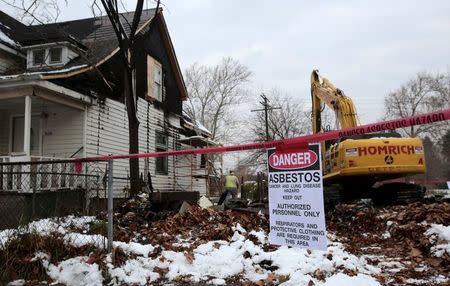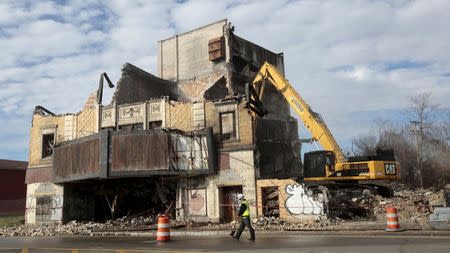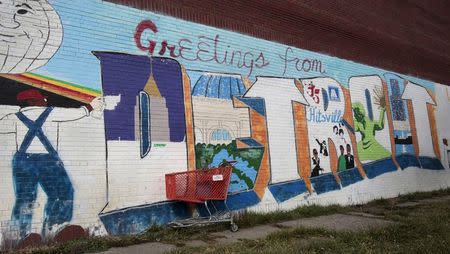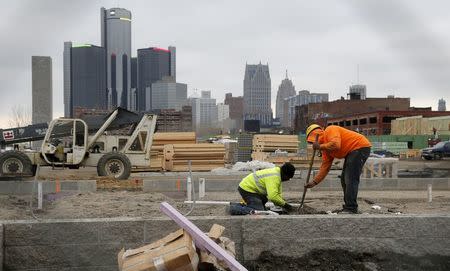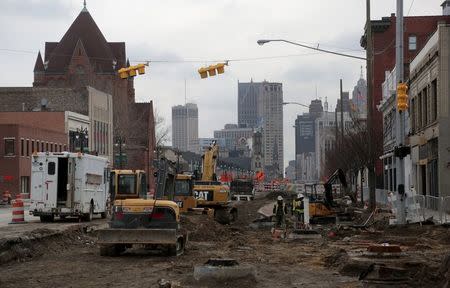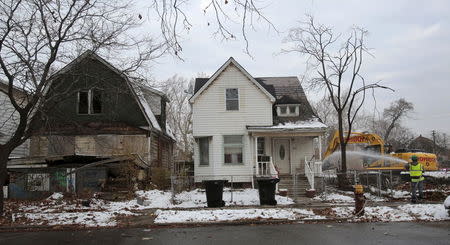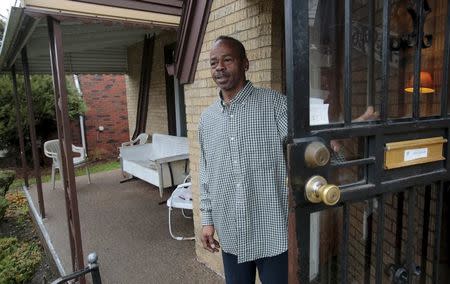Knocking down Detroit to revive it comes at a price
By Dave McKinney DETROIT (Reuters) - Nowhere in America bulldozes derelict homes with Detroit’s ferocity, as the city that has become a byword for U.S. urban decay seeks to engineer a recovery by tearing itself down. A year after the city exited the biggest-ever U.S. municipal bankruptcy, a plan to demolish half of its nearly 80,000 blighted or deteriorating structures -- nearly one in three city buildings -- is showing some signs of success. The number of fires - often caused by arson attacks on abandoned homes – dropped in October from a year ago, and deeply depressed property values have ticked higher in areas close to demolitions. The aim of the program is to stabilize home values and reduce foreclosures as the city of 680,000 people struggles with emptying neighborhoods, high crime and one of the worst unemployment rates in the country. But the federally backed program has been tainted by allegations that Mayor Mike Duggan favored demolition contractors who donated to his campaign and by a steep rise in costs. Federal and city probes into the allegations are underway. Duggan, whose program has razed more than 7,000 homes in two years, denies any wrongdoing. "I am proud of the work our team has done, and Detroiters should be, as well," said Duggan, who took office in January 2014 as Detroit’s first white mayor in nearly 40 years. Duggan was elected in November 2013 with "blight remediation" a key plank in a platform he built around a financial turnaround, economic development and reduced crime rates. The special inspector general for the U.S. Treasury Department’s Troubled Asset Relief Program -- from which Detroit gets its federal blight-relief dollars -- is investigating the city's demolition program. Agents visited the Michigan State Housing Development Authority, a state agency that is a pass-through for the federal funds, on Nov. 17 to discuss the matter, a spokeswoman for the state agency confirmed on Monday. The city's inspector general, James Heath, told Reuters the probe he launched in October into Duggan’s demolition program should conclude by March. Heath said he has not partnered with federal law-enforcement agencies. Duggan set a weekly demolition goal of 100 homes, which has Detroit destroying derelict properties at almost quadruple the pace of any other recipient of federal "blight-removal" dollars, federal records show. But demolition prices have fluctuated sharply. In October, he put the average 2015 price of razing a home at $16,400. A month later, after Heath opened his investigation, the administration cut the 2015 average to $13,830, citing lower contracting costs. Duggan's predecessor, Dave Bing, told Reuters prices remain too high. "The cost shouldn't have gone up that much," he said, noting that the price averaged as low as $8,500 per structure during his term between 2009 and 2013. Duggan attributes the price hike to his administration’s higher standards, including a faster demolition timetable. DOUBTS OVER BIDDING Critics have hit Duggan’s administration hardest for a now-discontinued bulk-demolition program in 2014, where pricing was discussed with four contractors before the $19.9 million project that razed 1,453 homes was publicly offered. Three of the companies later wound up as the only bidders on the deal. The mayor has said there was nothing improper about the arrangement and that the state of Michigan approved. "We did this in complete cooperation with the state," said Brian Farkas, special projects director for the Detroit Building Authority, which oversees the city's demolition work. Executives for two of the companies that wound up with the contracts collectively donated nearly $18,000 to the mayor since May 2013, campaign records show. Mayoral aides denied the contributions influenced the contract awards. But Rev. Charles Williams II, an influential African-American minister and Duggan foe, condemned the deal. "How is it a contractor can go into the office, set the price, and get the contract? To me, it's unprecedented," Williams said. If rules were broken, Duggan's aides say, President Barack Obama's administration would not have given another $21 million in demolition funds to Detroit in October, bringing the amount of federal backing for the city’s blight-elimination efforts to $121 million. A Department of Treasury official, whose office oversees the program, acknowledged "reported issues with Detroit's blight program and potential rising costs," but praised Duggan's efforts. "We recently visited Detroit, and you can see the real impact the blight program is having on communities," said Mark McArdle, the federal agency's deputy assistant secretary for financial stability. Duggan believes demolitions played a role in reducing arsons during this year’s three-day pre-Halloween period once known as "Devil's Night." At its peak, city records show, 810 arsons erupted in 1984 -- compared with 52 suspicious fires during the same October period this year. Between 2011 and 2014, arsons ranged between 93 and 97 during the period, records show. In another positive sign, a report by the Detroit analytics firm, Dynamo Metrics, showed occupied home values rose 4.2 percent on average between April 2014 and March 2015 near federally funded demolitions. But Jacques Welch, a 55-year-old factory worker, says his street is still waiting on City Hall. Near his brick home are a half-dozen abandoned houses with missing doors and windows that Welch says attract squatters and drug dealers. A vacant school stands a block away. “You get used to it,” he told Reuters from his front porch, resigned to the lack of progress in his neighborhood. “There's nothing else you can do." (Editing by Stuart Grudgings)
